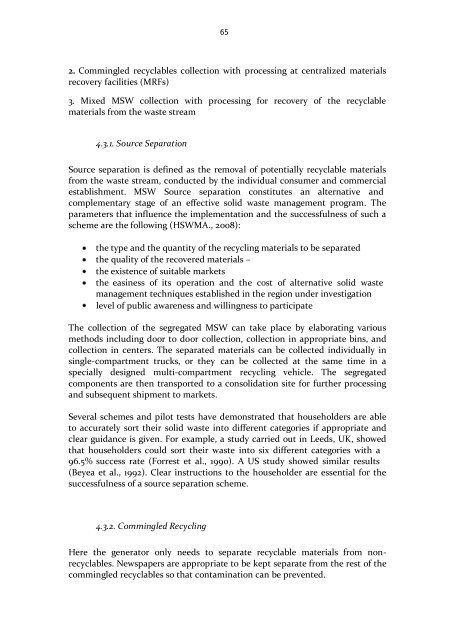(best examples and good practices) on household organic waste ...
(best examples and good practices) on household organic waste ...
(best examples and good practices) on household organic waste ...
Create successful ePaper yourself
Turn your PDF publications into a flip-book with our unique Google optimized e-Paper software.
65<br />
2. Commingled recyclables collecti<strong>on</strong> with processing at centralized materials<br />
recovery facilities (MRFs)<br />
3. Mixed MSW collecti<strong>on</strong> with processing for recovery of the recyclable<br />
materials from the <strong>waste</strong> stream<br />
4.3.1. Source Separati<strong>on</strong><br />
Source separati<strong>on</strong> is defined as the removal of potentially recyclable materials<br />
from the <strong>waste</strong> stream, c<strong>on</strong>ducted by the individual c<strong>on</strong>sumer <str<strong>on</strong>g>and</str<strong>on</strong>g> commercial<br />
establishment. MSW Source separati<strong>on</strong> c<strong>on</strong>stitutes an alternative <str<strong>on</strong>g>and</str<strong>on</strong>g><br />
complementary stage of an effective solid <strong>waste</strong> management program. The<br />
parameters that influence the implementati<strong>on</strong> <str<strong>on</strong>g>and</str<strong>on</strong>g> the successfulness of such a<br />
scheme are the following (HSWMA., 2008):<br />
the type <str<strong>on</strong>g>and</str<strong>on</strong>g> the quantity of the recycling materials to be separated<br />
the quality of the recovered materials –<br />
the existence of suitable markets<br />
the easiness of its operati<strong>on</strong> <str<strong>on</strong>g>and</str<strong>on</strong>g> the cost of alternative solid <strong>waste</strong><br />
management techniques established in the regi<strong>on</strong> under investigati<strong>on</strong><br />
level of public awareness <str<strong>on</strong>g>and</str<strong>on</strong>g> willingness to participate<br />
The collecti<strong>on</strong> of the segregated MSW can take place by elaborating various<br />
methods including door to door collecti<strong>on</strong>, collecti<strong>on</strong> in appropriate bins, <str<strong>on</strong>g>and</str<strong>on</strong>g><br />
collecti<strong>on</strong> in centers. The separated materials can be collected individually in<br />
single-compartment trucks, or they can be collected at the same time in a<br />
specially designed multi-compartment recycling vehicle. The segregated<br />
comp<strong>on</strong>ents are then transported to a c<strong>on</strong>solidati<strong>on</strong> site for further processing<br />
<str<strong>on</strong>g>and</str<strong>on</strong>g> subsequent shipment to markets.<br />
Several schemes <str<strong>on</strong>g>and</str<strong>on</strong>g> pilot tests have dem<strong>on</strong>strated that <strong>household</strong>ers are able<br />
to accurately sort their solid <strong>waste</strong> into different categories if appropriate <str<strong>on</strong>g>and</str<strong>on</strong>g><br />
clear guidance is given. For example, a study carried out in Leeds, UK, showed<br />
that <strong>household</strong>ers could sort their <strong>waste</strong> into six different categories with a<br />
96.5% success rate (Forrest et al., 1990). A US study showed similar results<br />
(Beyea et al., 1992). Clear instructi<strong>on</strong>s to the <strong>household</strong>er are essential for the<br />
successfulness of a source separati<strong>on</strong> scheme.<br />
4.3.2. Commingled Recycling<br />
Here the generator <strong>on</strong>ly needs to separate recyclable materials from n<strong>on</strong>recyclables.<br />
Newspapers are appropriate to be kept separate from the rest of the<br />
commingled recyclables so that c<strong>on</strong>taminati<strong>on</strong> can be prevented.










